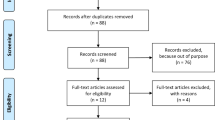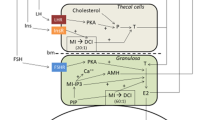Abstract
Purpose
The present study aims to investigate the effects of the combined therapy myo-inositol (MI) plus d-chiro-inositol (DCI) or d-chiro-inositol treatment in oocyte quality.
Methods
Polycystic ovary syndrome (PCOS) women undergoing IVF-ET were treated with myo-inositol combined with d-chiro-inositol in the physiological ratio (1.1 g myo-inositol plus 27.6 mg of d-chiro-inositol; INOFOLIC® combi Lo.Li.pharma) or d-chiro-inositol alone (500 mg; Interquim, s.a., Barcelona, Spain) to evaluate the umber of morphological mature oocytes, total International Units (IU) of recombinant FSH administered and the number of grade 1 embryos.
Results
The data clearly showed that only the combined therapy was able to improve oocyte and embryo quality, as well as pregnancy rates, in PCOS women undergoing IVF-ET.
Conclusion
The present paper further supports the hypothesis that MI plays a crucial role in the ovary in PCOS women. In particular, due to the physiological role played by MI and DCI, the combined therapy should represent a better choice.
Similar content being viewed by others
References
van Loendersloot LL, van Wely M, Limpens J, Bossuyt PM, Repping S, van der Veen F (2010) Predictive factors in in vitro fertilization (IVF): a systematic review and meta-analysis. Hum Reprod Update 16(6):577–589. doi:10.1093/humupd/dmq015
Rienzi L, Vajta G, Ubaldi F (2010) Predictive value of oocyte morphology in human IVF: a systematic review of the literature. Hum Reprod Update 17(1):34–45. doi:10.1093/humupd/dmq029
UNCE (2005) http://www.unece.org/stats/trends2005/family.htm
Revelli A, Delle Piane L, Casano S, Molinari E, Massobrio M, Rinaudo P (2009) Follicular fluid content and oocyte quality: from single biochemical markers to metabolomics. Reprod Biol Endocrinol 7:40. doi:10.1186/1477-7827-7-40
Chiu TT, Rogers MS, Law EL, Briton-Jones CM, Cheung LP, Haines CJ (2002) Follicular fluid and serum concentrations of myo-inositol in patients undergoing IVF: relationship with oocyte quality. Hum Reprod 17(6):1591–1596
Tamura H, Nakamura Y, Korkmaz A, Manchester LC, Tan DX, Sugino N, Reiter RJ (2009) Melatonin and the ovary: physiological and pathophysiological implications. Fertil Steril 92(1):328–343. doi:10.1016/j.fertnstert.2008.05.016
Papaleo E, Unfer V, Baillargeon JP, Fusi F, Occhi F, De Santis L (2009) Myo-inositol may improve oocyte quality in intracytoplasmic sperm injection cycles. A prospective, controlled, randomized trial. Fertil Steril 91(5):1750–1754. doi:10.1016/j.fertnstert.2008.01.088
Unfer V, Raffone E, Rizzo P, Buffo S (2011) Effect of a supplementation with myo-inositol plus melatonin on oocyte quality in women who failed to conceive in previous in vitro fertilization cycles for poor oocyte quality: a prospective, longitudinal, cohort study. Gynecol Endocrinol. doi:10.3109/09513590.2011.564687
Rizzo P, Raffone E, Benedetto V (2010) Effect of the treatment with myo-inositol plus folic acid plus melatonin in comparison with a treatment with myo-inositol plus folic acid on oocyte quality and pregnancy outcome in IVF cycles. A prospective, clinical trial. Eur Rev Med Pharmacol Sci 14(6):555–561
Chattopadhayay R, Ganesh A, Samanta J, Jana SK, Chakravarty BN, Chaudhury K (2010) Effect of follicular fluid oxidative stress on meiotic spindle formation in infertile women with polycystic ovarian syndrome. Gynecol Obstet Invest 69(3):197–202. doi:10.1159/000270900
Berker B, Kaya C, Aytac R, Satiroglu H (2009) Homocysteine concentrations in follicular fluid are associated with poor oocyte and embryo qualities in polycystic ovary syndrome patients undergoing assisted reproduction. Hum Reprod 24(9):2293–2302. doi:10.1093/humrep/dep069
Papaleo E, Unfer V, Baillargeon JP, Chiu TT (2009) Contribution of myo-inositol to reproduction. Eur J Obstet Gynecol Reprod Biol 147(2):120–123. doi:10.1016/j.ejogrb.2009.09.008
Huang LC, Fonteles MC, Houston DB, Zhang C, Larner J (1993) Chiroinositol deficiency and insulin resistance. III. Acute glycogenic and hypoglycemic effects of two inositol phosphoglycan insulin mediators in normal and streptozotocin-diabetic rats in vivo. Endocrinology 132(2):652–657
Zacche MM, Caputo L, Filippis S, Zacche G, Dindelli M, Ferrari A (2009) Efficacy of myo-inositol in the treatment of cutaneous disorders in young women with polycystic ovary syndrome. Gynecol Endocrinol 25(8):508–513. doi:10.1080/09513590903015544
Costantino D, Minozzi G, Minozzi E, Guaraldi C (2009) Metabolic and hormonal effects of myo-inositol in women with polycystic ovary syndrome: a double-blind trial. Eur Rev Med Pharmacol Sci 13(2):105–110
Genazzani AD, Lanzoni C, Ricchieri F, Jasonni VM (2008) Myo-inositol administration positively affects hyperinsulinemia and hormonal parameters in overweight patients with polycystic ovary syndrome. Gynecol Endocrinol 24(3):139–144. doi:10.1080/09513590801893232
Papaleo E, Unfer V, Baillargeon JP, De Santis L, Fusi F, Brigante C, Marelli G, Cino I, Redaelli A, Ferrari A (2007) Myo-inositol in patients with polycystic ovary syndrome: a novel method for ovulation induction. Gynecol Endocrinol 23(12):700–703. doi:10.1080/09513590701672405
Gerli S, Papaleo E, Ferrari A, Di Renzo GC (2007) Randomized, double blind placebo-controlled trial: effects of myo-inositol on ovarian function and metabolic factors in women with PCOS. Eur Rev Med Pharmacol Sci 11(5):347–354
Nestler JE, Jakubowicz DJ, Reamer P, Gunn RD, Allan G (1999) Ovulatory and metabolic effects of d-chiro-inositol in the polycystic ovary syndrome. N Engl J Med 340(17):1314–1320. doi:10.1056/NEJM199904293401703
Ciotta L, Stracquadanio M, Pagano I, Carbonaro A, Palumbo M, Gulino F (2011) Effects of myo-inositol supplementation on oocyte’s quality in PCOS patients: a double blind trial. Eur Rev Med Pharmacol Sci 15(5):509–514
Minozzi M, Costantino D, Guaraldi C, Unfer V (2011) The effect of a combination therapy with myo-inositol and a combined oral contraceptive pill versus a combined oral contraceptive pill alone on metabolic, endocrine, and clinical parameters in polycystic ovary syndrome. Gynecol Endocrinol. doi:10.3109/09513590.2011.564685
Cheang KI, Baillargeon JP, Essah PA, Ostlund RE Jr, Apridonize T, Islam L, Nestler JE (2008) Insulin-stimulated release of d-chiro-inositol-containing inositolphosphoglycan mediator correlates with insulin sensitivity in women with polycystic ovary syndrome. Metabolism 57(10):1390–1397. doi:10.1016/j.metabol.2008.05.008
Unfer V, Carlomagno G, Rizzo P, Raffone E, Roseff S (2011) Myo-inositol rather than d-chiro-inositol is able to improve oocyte quality in intracytoplasmic sperm injection cycles. A prospective, controlled, randomized trial. Eur Rev Med Pharmacol Sci 15(4):452–457
Pak Y, Huang LC, Lilley KJ, Larner J (1992) In vivo conversion of [3H]myoinositol to [3H]chiroinositol in rat tissues. J Biol Chem 267(24):16904–16910
Larner J (2002) d-chiro-inositol—its functional role in insulin action and its deficit in insulin resistance. Int J Exp Diabetes Res 3(1):47–60
Saito T, Jones CC, Huang S, Czech MP, Pilch PF (2007) The interaction of Akt with APPL1 is required for insulin-stimulated Glut4 translocation. J Biol Chem 282(44):32280–32287. doi:10.1074/jbc.M704150200
Broussard JA, Lin WH, Majumdar D, Anderson B, Eason B, Brown CM, Webb DJ (2012) The endosomal adaptor protein APPL1 impairs the turnover of leading edge adhesions to regulate cell migration. Mol Biol Cell 23(8):1486–1499. doi:10.1091/mbc.E11-02-0124
Borini A, Sciajno R, Bianchi V, Sereni E, Flamigni C, Coticchio G (2006) Clinical outcome of oocyte cryopreservation after slow cooling with a protocol utilizing a high sucrose concentration. Hum Reprod 21(2):512–517. doi:10.1093/humrep/dei346
Van de Velde H, Nagy ZP, Joris H, De Vos A, Van Steirteghem AC (1997) Effects of different hyaluronidase concentrations and mechanical procedures for cumulus cell removal on the outcome of intracytoplasmic sperm injection. Hum Reprod 12(10):2246–2250
De Santis L, Cino I, Rabellotti E, Papaleo E, Calzi F, Fusi FM, Brigante C, Ferrari A (2007) Oocyte cryopreservation: clinical outcome of slow-cooling protocols differing in sucrose concentration. Reprod Biomed Online 14(1):57–63
Isabella R, Raffone E (2012) Does ovary need d-chiro-inositol? J ovarian res 5(1):14. doi:10.1186/1757-2215-5-14
Agranoff BW (2009) Turtles all the way: reflections on myo-inositol. J Biol Chem 284(32):21121–21126. doi:10.1074/jbc.X109.004747
Kutateladze TG (2010) Translation of the phosphoinositide code by PI effectors. Nat Chem Biol 6(7):507–513. doi:10.1038/nchembio.390
Lahiri Majumder A, Biswas BB (eds) (2006) Biology of Inositols and Phosphoinositides. Subcellular Biochemistry, vol 39. Springer, New york
Berridge MJ (2009) Inositol trisphosphate and calcium signalling mechanisms. Biochim Biophys Acta 1793(6):933–940. doi:10.1016/j.bbamcr.2008.10.005
Chiu TT, Tam PP (1992) A correlation of the outcome of clinical in vitro fertilization with the inositol content and embryotrophic properties of human serum. J Assist Reprod Genet 9(6):524–530
Beemster P, Groenen P, Steegers-Theunissen R (2002) Involvement of inositol in reproduction. Nutr Rev 60(3):80–87
Goud PT, Goud AP, Leybaert L, Van Oostveldt P, Mikoshiba K, Diamond MP, Dhont M (2002) Inositol 1,4,5-trisphosphate receptor function in human oocytes: calcium responses and oocyte activation-related phenomena induced by photolytic release of InsP(3) are blocked by a specific antibody to the type I receptor. Mol Hum Reprod 8(10):912–918
Chiu TT, Rogers MS, Briton-Jones C, Haines C (2003) Effects of myo-inositol on the in vitro maturation and subsequent development of mouse oocytes. Hum Reprod 18(2):408–416
Gerli S, Mignosa M, Di Renzo GC (2003) Effects of inositol on ovarian function and metabolic factors in women with PCOS: a randomized double blind placebo-controlled trial. Eur Rev Med Pharmacol Sci 7(6):151–159
Carlomagno G, Unfer V, Roseff S (2011) The d-chiro-inositol paradox in the ovary. Fertil Steril 95(8):2515–2516. doi:10.1016/j.fertnstert.2011.05.027
Nechamen CA, Thomas RM, Cohen BD, Acevedo G, Poulikakos PI, Testa JR, Dias JA (2004) Human follicle-stimulating hormone (FSH) receptor interacts with the adaptor protein APPL1 in HEK 293 cells: potential involvement of the PI3K pathway in FSH signaling. Biol Reprod 71(2):629–636. doi:10.1095/biolreprod.103.025833
Ma XW, Ding S, Ma XD, Gu N, Guo XH (2011) Genetic variability in adapter proteins with APPL1/2 is associated with the risk of coronary artery disease in type 2 diabetes mellitus in Chinese Han population. Chin Med J (Engl) 124(22):3618–3621
Raffone E, Rizzo P, Benedetto V (2010) Insulin sensitiser agents alone and in co-treatment with r-FSH for ovulation induction in PCOS women. Gynecol Endocrinol 26(4):275–280. doi:10.3109/09513590903366996
Tian L, Luo N, Zhu X, Chung BH, Garvey WT, Fu Y (2012) Adiponectin–AdipoR1/2–APPL1 signaling axis suppresses human foam cell formation: differential ability of AdipoR1 and AdipoR2 to regulate inflammatory cytokine responses. Atherosclerosis 221(1):66–75. doi:10.1016/j.atherosclerosis.2011.12.014
Bohdanowicz M, Balkin DM, De Camilli P, Grinstein S (2012) Recruitment of OCRL and Inpp 5B to phagosomes by Rab5 and APPL1 depletes phosphoinositides and attenuates Akt signaling. Mol Biol Cell 23(1):176–187. doi:10.1091/mbc.E11-06-0489
Pal L, Jindal S, Witt BR, Santoro N (2008) Less is more: increased gonadotropin use for ovarian stimulation adversely influences clinical pregnancy and live birth after in vitro fertilization. Fertil Steril 89(6):1694–1701. doi:10.1016/j.fertnstert.2007.05.055
Pak Y, Paule CR, Bao YD, Huang LC, Larner J (1993) Insulin stimulates the biosynthesis of chiro-inositol-containing phospholipids in a rat fibroblast line expressing the human insulin receptor. Proc Natl Acad Sci USA 90(16):7759–7763
Larner J, Brautigan DL, Thorner MO (2010) d-chiro-inositol glycans in insulin signaling and insulin resistance. Mol Med 16 (11–12):543–552. doi:10.2119/molmed.2010.00107
Larner J (2001) d-chiro-inositol in insulin action and insulin resistance-old-fashioned biochemistry still at work. IUBMB Life 51(3):139–148. doi:10.1080/152165401753544205
Conflict of interest
None.
Author information
Authors and Affiliations
Corresponding author
Rights and permissions
About this article
Cite this article
Colazingari, S., Treglia, M., Najjar, R. et al. The combined therapy myo-inositol plus d-chiro-inositol, rather than d-chiro-inositol, is able to improve IVF outcomes: results from a randomized controlled trial. Arch Gynecol Obstet 288, 1405–1411 (2013). https://doi.org/10.1007/s00404-013-2855-3
Received:
Accepted:
Published:
Issue Date:
DOI: https://doi.org/10.1007/s00404-013-2855-3




